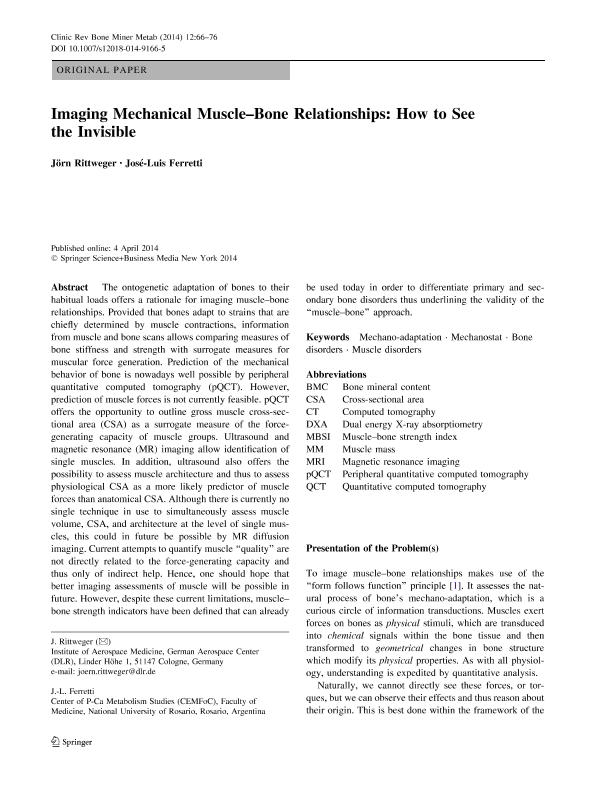Artículo
Imaging Mechanical Muscle–Bone Relationships: How to See the Invisible
Fecha de publicación:
06/2014
Editorial:
Springer
Revista:
Journal of Musculoskeletal and Neuronal Interactions
ISSN:
1108-7161
Idioma:
Inglés
Tipo de recurso:
Artículo publicado
Clasificación temática:
Resumen
The ontogenetic adaptation of bones to their habitual loads offers a rationale for imaging muscle–bone relationships. Provided that bones adapt to strains that are chiefly determined by muscle contractions, information from muscle and bone scans allows comparing measures of bone stiffness and strength with surrogate measures for muscular force generation. Prediction of the mechanical behavior of bone is nowadays well possible by peripheral quantitative computed tomography (pQCT). However, prediction of muscle forces is not currently feasible. pQCT offers the opportunity to outline gross muscle cross-sectional area (CSA) as a surrogate measure of the force-generating capacity of muscle groups. Ultrasound and magnetic resonance (MR) imaging allow identification of single muscles. In addition, ultrasound also offers the possibility to assess muscle architecture and thus to assess physiological CSA as a more likely predictor of muscle forces than anatomical CSA. Although there is currently no single technique in use to simultaneously assess muscle volume, CSA, and architecture at the level of single muscles, this could in future be possible by MR diffusion imaging. Current attempts to quantify muscle “quality” are not directly related to the force-generating capacity and thus only of indirect help. Hence, one should hope that better imaging assessments of muscle will be possible in future. However, despite these current limitations, muscle–bone strength indicators have been defined that can already be used today in order to differentiate primary and secondary bone disorders thus underlining the validity of the “muscle–bone” approach.
Palabras clave:
Mechano-Adaptation
,
Mechanostat
,
Bone Disorders
,
Muscle Disorders
Archivos asociados
Licencia
Identificadores
Colecciones
Articulos(CCT - ROSARIO)
Articulos de CTRO.CIENTIFICO TECNOL.CONICET - ROSARIO
Articulos de CTRO.CIENTIFICO TECNOL.CONICET - ROSARIO
Citación
Rittweger, Jorn; Ferretti, Jose Luis; Imaging Mechanical Muscle–Bone Relationships: How to See the Invisible; Springer; Journal of Musculoskeletal and Neuronal Interactions; 12; 2; 6-2014; 66-76
Compartir




